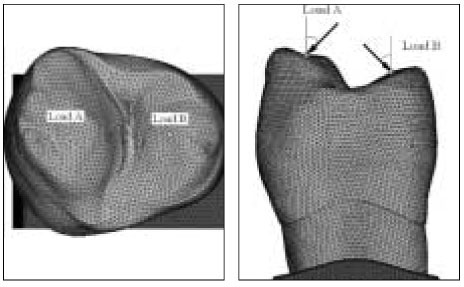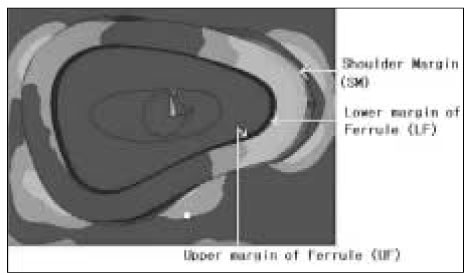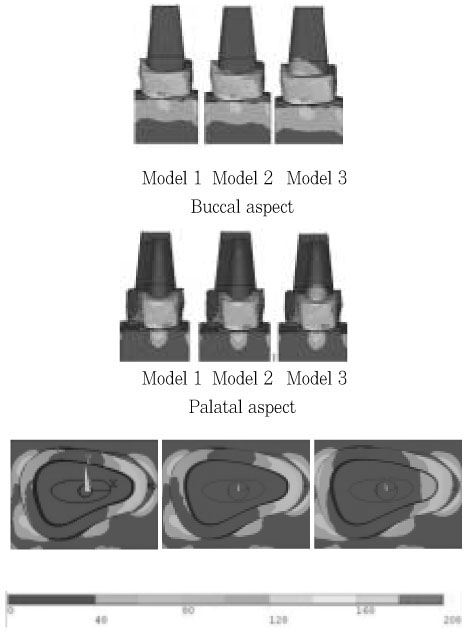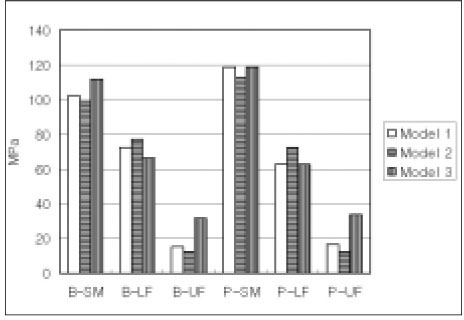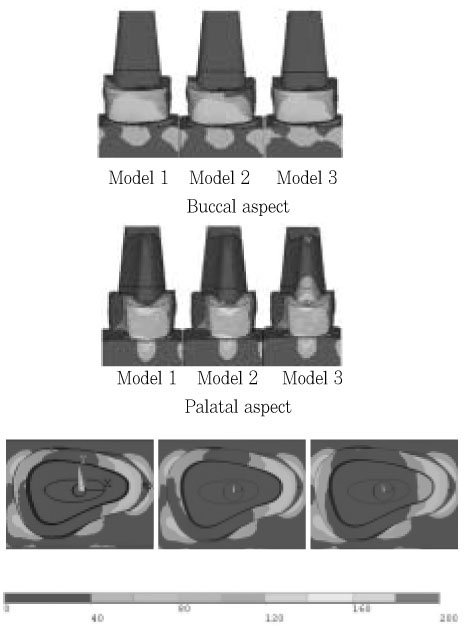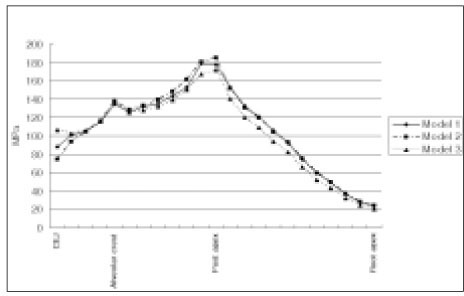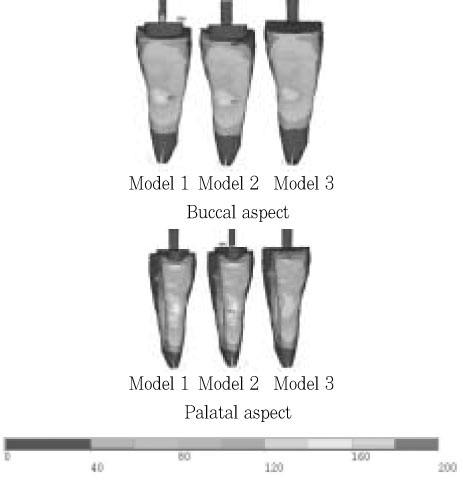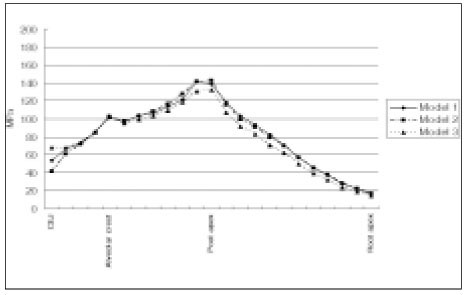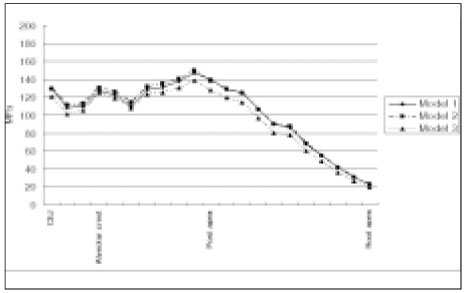J Korean Acad Conserv Dent.
2009 Jan;34(1):69-79. 10.5395/JKACD.2009.34.1.069.
Stress distribution of endodontically treated maxillary second premolars restored with different methods: Three-dimensional finite element analysis
- Affiliations
-
- 1Department of Conservative dentistry, School of Dentistry, Pusan National University, Korea.
- 2Department of Mechanical design engineering, College of Engineering, Pusan National University, Korea.
- KMID: 2176045
- DOI: http://doi.org/10.5395/JKACD.2009.34.1.069
Abstract
- The purpose of this study was to evaluate the influence of elastic modulus of restorative materials and the number of interfaces of post and core systems on the stress distribution of three differently restored endodontically treated maxillary second premolars using 3D FE analysis. Model 1, 2 was restored with a stainless steel or glass fiber post and direct composite resin. A PFG or a sintered alumina crown was considered. Model 3 was restored by EndoCrown. An oblique 500 N was applied on the buccal (Load A) and palatal (Load B) cusp. The von Mises stresses in the coronal and root structure of each model were analyzed using ANSYS. The elastic modulus of the definitive restorations rather than the type of post and core system was the primary factor that influenced the stress distribution of endodontically treated maxillary premolars. The stress concentration at the coronal structure could be lowered through the use of definitive restoration of high elastic modulus. The stress concentration at the root structure could be lowered through the use of definitive restoration of low elastic modulus.
Keyword
MeSH Terms
Figure
Cited by 1 articles
-
Influence of post types and sizes on fracture resistance in the immature tooth model
Jong-Hyun Kim, Sung-Ho Park, Jeong-Won Park, Il-Young Jung
J Korean Acad Conserv Dent. 2010;35(4):257-266. doi: 10.5395/JKACD.2010.35.4.257.
Reference
-
1. Nagasiri R, Chitmongkolsuk S. Long-term survival of endodontically treated molars without crown coverage: a retrospective cohort study. J Prosthet Dent. 2005. 93:164–170.
Article2. Teixeira EC, Teixeira FB, Piasick JR, Thompson JY. An in vitro assessment of prefabricated fiber post system. J Am Dent Assoc. 2006. 137:1006–1012.3. Maccari PC, onceição EN, Nunes MF. Fracture resistance of endodontically treated teeth restored with three different prefabricated esthetic posts. J Esthet Restor Dent. 2003. 15:25–30.
Article4. Zalkind M, Hochman N. Esthetic considerations in restoring endodontically treated teeth with posts and cores. J Prosthet Dent. 1998. 79:702–705.
Article5. Cheung W. A review of the management of endodontically treated teeth. Post, core and the final restoration. J Am Dent Assoc. 2005. 136:611–619.6. Lassila LV, Tanner J, Le Bell AM, Narva K, Vallittu PK. Flexural properties of fiber reinforced root canal posts. Dent Mater. 2004. 20:29–36.
Article7. Genovese K, Lamberti L, Pappalettere C. Finite element analysis of a new customized composite post system for endodontically treated teeth. J Biomech. 2005. 38:2375–2389.
Article8. Fernandes AS, Shetty S, Coutinho I. Factors determining post selection: a literature review. J Prosthet Dent. 2003. 90:556–562.
Article9. Baldissara P, Di Grazia V, Palano A, Ciocca L. Fatigue resistance of restored endodontically treated teeth: a multiparametric analysis. Int J Prosthodont. 2006. 19:25–27.10. Zarone F, Sorrentino R, Apicella D, Valentino B, Ferrari M, Aversa R, Apicella A. Evaluation of the biomechanical behavior of maxillary central incisors restored by means of endocrowns compared to a natural tooth: a 3D static linear finite elements analysis. Dent Mater. 2006. 22:1035–1044.
Article11. Ortega VL, Pegoraro LF, Conti PC, do Valle AL, Bonfante G. Evaluation of fracture resistance of endodontically treated maxillary premolars, restored with ceromer or heat-pressed ceramic inlays and fixed with dual-resin cements. J Oral Rehabil. 2004. 31:393–397.
Article12. Otto T. Computer-aided direct all-ceramic crowns: preliminary 1-year results of a prospective clinical study. Int J Periodontics Restorative Dent. 2004. 24:446–455.
Article13. Cohen BI, Condos S, Musikant BL, Deutsch AS. Pilot study comparing the photoelastic stress distribution for four endodontic post systems. J Oral Rehabil. 1996. 23:679–685.
Article14. Ross RS, Nicholls JI, Harrington GW. A comparison of strains generated during placement of five endodontic posts. J Endod. 1991. 17:450–456.
Article15. Lee HM, Hur B, Kim HC, Woo SG, Kim KH, Son K, Park JK. Effects of occlusal load on the cervical stress distribution : A three-dimensional finite element study. J Korean Acad Conserv Dent. 2006. 31:427–436.
Article16. Toparli M. Stress analysis in a post-restored tooth utilizing the finite element method. J Oral Rehabil. 2003. 30:470–476.
Article17. Park JK, Hur B, Kim SK. The influence of combining composite resins with different elastic modulus on the stress distribution of class V restoration: A three-dimensional finite element study. J Korean Acad Conserv Dent. 2008. 33:184–197.
Article18. Lanza A, Aversa R, Rengo S, Apicella D, Apicella A. 3D FEA of cemented steel, glass and carbon posts in a maxillary incisor. Dent Mater. 2005. 21:709–715.
Article19. Rosenstiel , Land , Fujimoto . Textbook of contemporary fixed prostodontics. 2001. 3rd edition. Mosby;216–229.20. Cheong YK, Hur B, Lee HJ. A comparison of post and core techniques with finite element analysis. J Korean Acad Conserv Dent. 1996. 21:70–86.21. Cormier CJ, Burns DR, Moon P. In vitro comparison of the fracture resistance and failure mode of fiber, ceramic, and conventional post systems at various stages of restoration. J Prosthodont. 2001. 10:26–36.
Article22. Butz F, Lennon AM, Heydecke G, Strub JR. Survival rate and fracture strength of endodontically treated maxillary incisors with different post and core system. Int J Prosthodont. 2001. 14:58–64.23. Mannocci F, Ferrari M, Watson TF. Intermittent loading of teeth restored using quartz fiber, and zirconium dioxide ceramic root canal posts. J Adhes Dent. 1999. 1:153–158.24. Rosentritt M, Furer C, Behr M, Lang R, Handel G. Comparison of in vitro fracture strength of metallic and tooth-coloured post and cores. J Oral Rehabil. 2000. 27:595–601.
Article25. Akkayan B, Gulmez T. Resistance to fracture of endodontically treated teeth restored with different post systems. J Prosthet Dent. 2002. 87:431–437.
Article26. Assif D, Oren E, Marshak BL, Aviv I. Photoelastic analysis of stress transfer by endodontically treated teeth to the supporting structure using different restorative techniques. J Prosthet Dent. 1989. 61:535–543.
Article27. Akkayan B. An in vitro study evaluating the effect of ferrule length on fracture resistance of endodontically treated teeth restored with fiber-reinforced and zirconia dowel systems. J Prosthet Dent. 2004. 92:155–162.
Article28. Dietschi D, Romelli M, Goretti A. Adaptation of adhesive posts and cores to dentin after fatigue testing. Int J Prosthodont. 1997. 10:498–507.29. Hunter AJ, Flood AM. The restoration of endodontically treated teeth. Part 3. Cores. Aust Dent J. 1989. 34:115–121.
Article30. Pegoretti A, Fambri L, Zappini G, Bianchetti M. Finite element analysis of a glass fibre reinforced composite endodontic post. Biomaterials. 2002. 23:2667–2682.
Article31. Stricker EJ, Göhring TN. Influence of different posts and cores on marginal adaptation, fracture resistance, and fracture mode of composite resin crowns on human mandibular premolars. An in vitro study. J Dent. 2006. 34:326–335.
Article32. Oyar P, Ulusoy M, Eskitascioglu G. The element analysis of stress distribution of 2 different tooth preparation designs in porcelain-fused-to-metal crowns. Int J Prosthodont. 2006. 19:85–91.33. Williams KR, Edmundson JT. A finite element stress analysis of an endodontically restored tooth. Eng Med. 1984. 13:167–173.
Article34. Cailleteau JG, Rieger MR, Rieger MR, Akin JE. A comparison of intracanal stresses in a post-restored tooth utilizing the finite element method. J Endod. 1992. 18:540–544.
Article35. de Castro Albuquerque R, Polleto LT, Fontana RH, Cimini CA. Stress analysis of an upper central incisor restored with different posts. J Oral Rehabil. 2003. 30:936–943.
Article36. Hayashi M, Takahashi M, Takahashi M, Imazato S, Ebisu S. Fracture resistance of pulpless teeth restored with post-cores and crowns. Dent Mater. 2006. 22:477–485.
Article37. Gu XH, Kern M. Fracture resistance of crowned incisors with different post systems and luting agents. J Oral Rehabil. 2006. 33:918–923.
Article38. Newman MP, Yaman P, Dennison J, Rafter M, Billy E. Fracture resistance of endodontically treated teeth restored with composite posts. J Prosthet Dent. 2003. 89:360–367.
Article
- Full Text Links
- Actions
-
Cited
- CITED
-
- Close
- Share
- Similar articles
-
- Effect of restoration type on the stress distribution of endodontically treated maxillary premolars; Three-dimensional finite element study
- A three-dimensional Finite element analysis for initial stress of maxillary incisors during activation of upper utility arch wire
- The effect of restorative materials on the stress distribution of class V composite resin restorations: a 3D finite element investigation
- Critical evaluation of fracture strength testing for endodontically treated teeth: a finite element analysis study
- A finite element analysis on the effect of the reverse headgear to the maxillary complex


